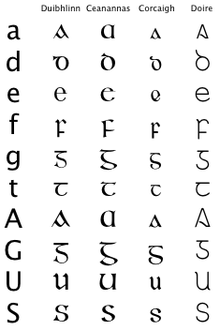Gaelic type: Difference between revisions
No edit summary |
Update URL |
||
| Line 54: | Line 54: | ||
* [[Michael Everson]]'s [http://www.evertype.com/celtscript Celtscript range of fonts] |
* [[Michael Everson]]'s [http://www.evertype.com/celtscript Celtscript range of fonts] |
||
* Brendan Leen's [http://136.206.208.1/library/LIBeng/Special%20Collections/spcoll4cent.htm Four centuries of printing in the Irish character], Cregan Library, St Patrick's College, Drumcondra |
* Brendan Leen's [http://136.206.208.1/library/LIBeng/Special%20Collections/spcoll4cent.htm Four centuries of printing in the Irish character], Cregan Library, St Patrick's College, Drumcondra |
||
* Vincent Morley's [http://www. |
* Vincent Morley's [http://www.scribhinn.org/ An Cló Gaelach] (in Irish) |
||
* Mathew D. Staunton's [http://www.unicaen.fr/mrsh/lisa/publications/008/v3_2005-1_085staunton.pdf Trojan Horses and Friendly Faces: Irish Gaelic Typography as Propaganda]. ''[http://www.unicaen.fr/mrsh/lisa/indexGb.php?p= La revue LISA]''. [[ISSN]] 1762-6153. Vol. III; n°1. 2005. |
* Mathew D. Staunton's [http://www.unicaen.fr/mrsh/lisa/publications/008/v3_2005-1_085staunton.pdf Trojan Horses and Friendly Faces: Irish Gaelic Typography as Propaganda]. ''[http://www.unicaen.fr/mrsh/lisa/indexGb.php?p= La revue LISA]''. [[ISSN]] 1762-6153. Vol. III; n°1. 2005. |
||
Revision as of 13:17, 17 November 2008
| Latin script (Gaelic variant) | |
|---|---|
 | |
| Script type | |
Time period | ? |
| Direction | Left-to-right |
| Languages | Irish |
| ISO 15924 | |
| ISO 15924 | Latg (216), Latin (Gaelic variant) |
The term Gaelic type, a translation of the Irish phrase cló Gaelach (pronounced /kɫ̪oː ˈgeːɫ̪əx/), refers to a family of insular typefaces devised for writing Irish and used between the 16th and 20th centuries. Sometimes, all Gaelic typefaces are called Celtic or uncial. In Ireland the term cló Gaelach is used in opposition to the term cló Rómhánach, in English 'Roman type'.
Characteristics

Besides the 26 letters of the Latin alphabet, Gaelic typefaces must include any vowels with acute accents (Áá Éé Íí Óó Úú) as well as a set of consonants with dot above (Ḃḃ Ċċ Ḋḋ Ḟḟ Ġġ Ṁṁ Ṗṗ Ṡṡ Ṫṫ), and the Tironian sign et "⁊", used for agus 'and' in Irish. Gaelic typefaces also often include insular forms of the letters s and r, and some of them contain a number of ligatures used in earlier Gaelic typography and deriving from the manuscript tradition. Lower-case i is drawn without a dot (though it is not the Turkish dotless ı), and the letters d, f, g, and t have insular shapes. Many modern Gaelic typefaces include Gaelic letterforms for the letters j, k, q, v, w, x, y, and z, and typically provide support for at least the vowels of the other Celtic languages. They also distinguish between & and ⁊ (as did traditional typography), though some modern fonts mistakenly replace the ampersand with the Tironian note ostensibly because both mean 'and'.
Origin

The Irish uncial alphabet originated in medieval manuscripts as an "insular" variant of the Latin alphabet. The first Gaelic typeface was designed in 1571 for a catechism commissioned by Elizabeth I to help bring the Irish people to Protestantism.
Use
Typesetting in Gaelic script remained common in Ireland until the mid-20th century. Gaelic script is today used merely for decorative typesetting; for example, a number of traditional Irish newspapers still print their name in Gaelic script on the first page, and it is also popular for pub signs, greeting cards, and display advertising. Edward Lhuyd's grammar of the Cornish language used Gaelic-script consonants to indicate sounds like [ð] and [θ].
Gaelic script in Unicode
Unicode treats the Gaelic script a font variant of the Latin alphabet, with the exception of letters like insular G () which is encoded at U+1D79 "ᵹ" (with its capital at U+A77D "Ᵹ" as of Unicode 5.1) because it is used alongside regular (non-Gaelic) Latin characters for certain purposes, usually phonetic transcription. Other Gaelic script letters were added to Unicode 5.1: ꝼU+A779-A77A insular D "Ꝺ ꝺ"; U+A77B-A77C insular F "Ꝼ ꝼ"; U+A77E-A77F turned insular G "Ꝿ ꝿ"; U+A782-A783 insular R "Ꞃ ꞃ"; U+A784-A785 insular S "Ꞅ ꞅ"; and U+A786-A787 insular T "Ꞇ ꞇ".
Samples


The first Irish sentence in each figure above, Chuaigh bé mhórshách le dlúthspád fíorfhinn trí hata mo dhea-phorcáin bhig, is a pangram meaning 'A greatly satisfied woman went with a truly white dense spade through the hat of my good little well-fattened pig'. The second sentence reads Duibhlinn/Ceanannas an cló a úsáidtear anseo 'Duibhlinn/Ceannanas is the font used here'. The second sentence uses the short forms of the letters r and s; the first uses the long forms.
See also
- Blackletter; Fraktur (typeface)
- Insular script
- Irish orthography
- Latin alphabet
- Uncial
- Theobald Stapleton (who devised an Antiqua orthography for Irish in 1639)
Bibliography
- Lynam, E. W. 1969. The Irish character in print: 1571–1923. New York: Barnes & Noble. First printed as Oxford University Press offprint 1924 in Transactions of the Bibliographical Society, 4th Series, Vol. IV, No. 4, March 1924.)
- McGuinne, Dermot. Irish type design: A history of printing types in the Irish character. Blackrock: Irish Academic Press. ISBN 0-7165-2463-5
Sources, external links
- Michael Everson's History and classification of Gaelic typefaces, 2000-06-19
- Michael Everson's Celtscript range of fonts
- Brendan Leen's Four centuries of printing in the Irish character, Cregan Library, St Patrick's College, Drumcondra
- Vincent Morley's An Cló Gaelach (in Irish)
- Mathew D. Staunton's Trojan Horses and Friendly Faces: Irish Gaelic Typography as Propaganda. La revue LISA. ISSN 1762-6153. Vol. III; n°1. 2005.
